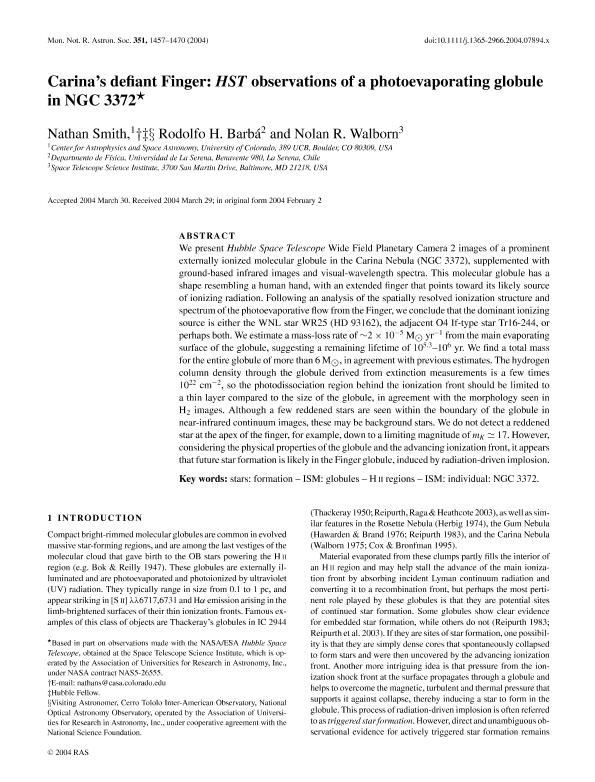Mostrar el registro sencillo del ítem
dc.contributor.author
Smith, Nathan
dc.contributor.author
Barba, Rodolfo Héctor

dc.contributor.author
Walborn, Nolan Revere

dc.date.available
2023-10-18T12:53:36Z
dc.date.issued
2004-12
dc.identifier.citation
Smith, Nathan; Barba, Rodolfo Héctor; Walborn, Nolan Revere; Carina's defiant finger: HST observations of a photoevaporating globule in NGC 3372; Wiley Blackwell Publishing, Inc; Monthly Notices of the Royal Astronomical Society; 351; 4; 12-2004; 1457-1470
dc.identifier.issn
0035-8711
dc.identifier.uri
http://hdl.handle.net/11336/215282
dc.description.abstract
We present Hubble Space Telescope Wide Field Planetary Camera 2 images of a prominent externally ionized molecular globule in the Carina Nebula (NGC 3372), supplemented with ground-based infrared images and visual-wavelength spectra. This molecular globule has a shape resembling a human hand, with an extended finger that points toward its likely source of ionizing radiation. Following an analysis of the spatially resolved ionization structure and spectrum of the photoevaporative flow from the Finger, we conclude that the dominant ionizing source is either the WNL star WR25 (HD 93162), the adjacent O4 If-type star Trl6-244, or perhaps both. We estimate a mass-loss rate of ∼2 × 10-5 M⊙ yr-1 from the main evaporating surface of the globule, suggesting a remaining lifetime of 10 5.3-106 yr. We find a total mass for the entire globule of more than 6 M⊙ , in agreement with previous estimates. The hydrogen column density through the globule derived from extinction measurements is a few times 1022 cm-2, so the photodissociation region behind the ionization front should be limited to a thin layer compared to the size of the globule, in agreement with the morphology seen in H2 images. Although a few reddened stars are seen within the boundary of the globule in near-infrared continuum images, these may be background stars. We do not detect a reddened star at the apex of the finger, for example, down to a limiting magnitude of mk≃ 17. However, considering the physical properties of the globule and the advancing ionization front, it appears that future star formation is likely in the Finger globule, induced by radiation-driven implosion.
dc.format
application/pdf
dc.language.iso
eng
dc.publisher
Wiley Blackwell Publishing, Inc

dc.rights
info:eu-repo/semantics/openAccess
dc.rights.uri
https://creativecommons.org/licenses/by-nc-sa/2.5/ar/
dc.subject
ISM: GLOBULES - H II REGIONS
dc.subject
ISM: INDIVIDUAL: NGC 3372
dc.subject
STARS: FORMATION
dc.subject.classification
Astronomía

dc.subject.classification
Ciencias Físicas

dc.subject.classification
CIENCIAS NATURALES Y EXACTAS

dc.title
Carina's defiant finger: HST observations of a photoevaporating globule in NGC 3372
dc.type
info:eu-repo/semantics/article
dc.type
info:ar-repo/semantics/artículo
dc.type
info:eu-repo/semantics/publishedVersion
dc.date.updated
2023-07-07T20:32:15Z
dc.journal.volume
351
dc.journal.number
4
dc.journal.pagination
1457-1470
dc.journal.pais
Reino Unido

dc.journal.ciudad
Londres
dc.description.fil
Fil: Smith, Nathan. State University of Colorado at Boulder; Estados Unidos
dc.description.fil
Fil: Barba, Rodolfo Héctor. Universidad de La Serena; Chile. Consejo Nacional de Investigaciones Científicas y Técnicas; Argentina
dc.description.fil
Fil: Walborn, Nolan Revere. Space Telescope Science Institute; Estados Unidos
dc.journal.title
Monthly Notices of the Royal Astronomical Society

dc.relation.alternativeid
info:eu-repo/semantics/altIdentifier/doi/http://dx.doi.org/10.1111/j.1365-2966.2004.07894.x
dc.relation.alternativeid
info:eu-repo/semantics/altIdentifier/url/https://academic.oup.com/mnras/article/351/4/1457/1135777
Archivos asociados
